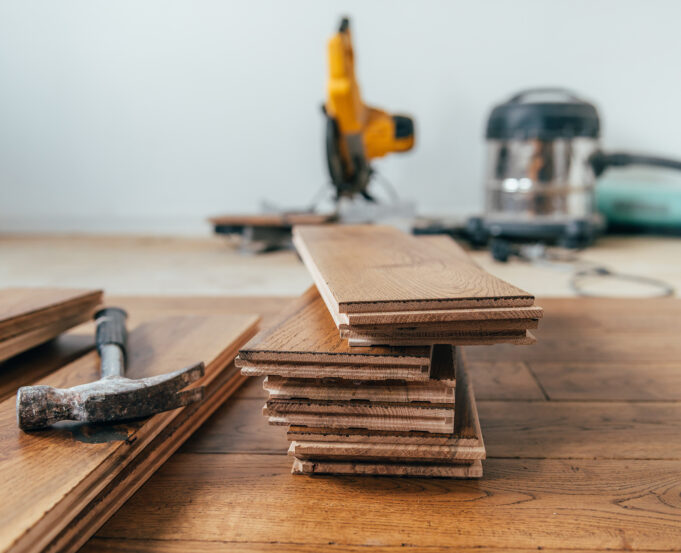Many factors affect the cost to install new hardwood floors in your home. Here’s what to expect and how to budget accordingly.
Hardwood flooring is one of the most popular flooring options for homeowners and was once a staple of stately homes. The vintage feel and overall durability make it a classic choice that is hard to beat. But hardwood flooring is also generally expensive. So before you begin your renovation, you’ll need to decide if the cost of hardwood floors matches the value.
According to Thumbtack, the average cost to install solid wood floors is $5-$10 per square foot and, slightly less at $4-$9 per square foot to install engineered wood. The variance is based on the type of wood you use and the complexity of the installation process. The species, grade, cut, and quality of the wood plays a large part in determining the total installation costs.
Consider the Species of Wood
There are many species of wood to choose from, but common choices for hardwood are cherry, walnut, oak, maple, and hickory. Each varies in style and price. There is a measure of hardness called Janka to rank hardwood. The higher the Janka score, the more pounds of force (lbf) the wood can withstand. Hickory is one of the hardest American hardwoods with a Janka score of 1,820 lbf. Maple is between 1,450 and 1,500, and red oak is 1290. Walnut and cherry have a lower Janka score but are suitable for flooring.
White oak, red oak, and maple are some of the most affordable domestic hardwoods. Walnut, cherry, and ash can cost more depending on availability. Imported or exotic varieties are the costliest hardwood species, with teak, mahogany, Tigerwood, and Brazilian Ebony among the popular varieties that are more expensive.
Most years, you’ll want to start with your preference of wood species first, then find a supplier. But given supply chain shortages, you should start by measuring the amount of flooring you need, then looking for a wood variety that is available in the quantities needed. Wood varieties can be stained to match the natural color of another variety. This workaround might be appealing to keep costs low and ensure that you have enough wood available to complete the job.
The rule of thumb is to order 5% to 10% more than you think you need. This will cover any loss from trimming or the occasional miscut.
Types of Wood Flooring
There are two wood flooring options available: solid wood planks and engineered hardwood planks. Solid wood planks are authentic pieces of wood. The average cost for solid wood planks is $3-$8 per square foot and installation costs roughly $5-$12 per square foot. If properly cared for, solid hardwood planks have a 100+ year life span.
Engineered hardwood has two layers. The lower layer consists of crossed plywood made from less expensive wood. The top layer is a solid hardwood. Engineered wood costs $3-$8 per square foot and $5-$8 per square foot for installation. The lifespan is 30-50 years. Aside from the cost, the most common benefit of engineered hardwood is that it handles moisture well. These planks are ideal in bathrooms, kitchens, and other places that attract high humidity.
Hardwood Floor Installation Considerations
Hardwood installation typically starts with removing a home’s existing flooring. The cost for removal varies depending on the materials in place and the area covered. Carpet is easier to remove and costs around $1 per square foot, whereas glued-down flooring costs around $2-$4 per square foot to remove.
The installation cost increases significantly if self-leveling concrete needs to be used to fix low spots in the concrete or if the subfloor needs to be replaced. Expect to pay between $1,000 and $1,500 for materials and labor to pour concrete to level the subfloor.
The installation requirements for different types of hardwood, especially engineered hardwood, vary significantly. It is important to always check the manufacturer’s guidelines to learn if subflooring or other supports are recommended. Of course, these come with a price tag of their own.
If there are many cuts and trims of hardwood needed to cover the floor, installation will take more time and could cost more money. This might be the case in a home with a non-traditional layout or lots of alcoves or angles. Also, installing hardwood on stairs is usually estimated separately because installation costs more for this time-consuming work.
Of course, if you’re handy and patient, installing hardwood flooring yourself could shave hundreds off the total cost. But installation companies tend to bring large crews that can speedily get the job done, so your family can get back to living faster. DIY projects of this magnitude can be disruptive and lengthier than anticipated.
Hardwood Flooring Finishes
Less expensive finishes include water-based and oil-based polyurethane, which is DIY-friendly and easy to use. Pricier professional-quality finishes include acid-cured and penetrating oil finishes. Aluminum oxide is primarily available on factory-finished hardwood planks.
The hardwood finish you choose impacts the cost, but finishes protect the wood so this is not the place to skimp on value. Choose the finish that’s best for the wood variety you have chosen.
How to Save on Hardwood Flooring
For savings, consider refinishing instead of replacing worn hardwood floors. Refinishing hardwood is generally less expensive than installing it new.
You can also save by pulling up the existing flooring yourself. Carpets, in particular, tend to be easy to remove, making it an easy way to save.
Lastly, shop around for different wood species. Note that the appearance of the wood grain can affect the price; the clearer the grade, the more expensive. And remember: staining a less expensive wood can generate the same aesthetic as buying a more expensive variety with the same hue.
Written by Better Homes & Gardens | View the original article published by American Apartment Owners Association











